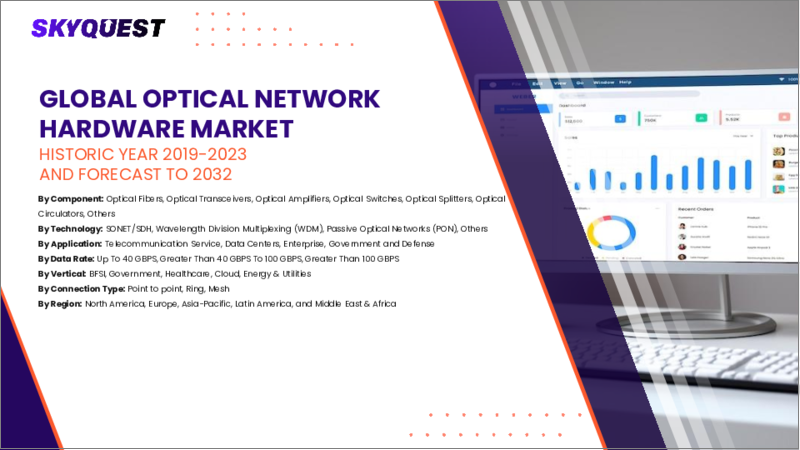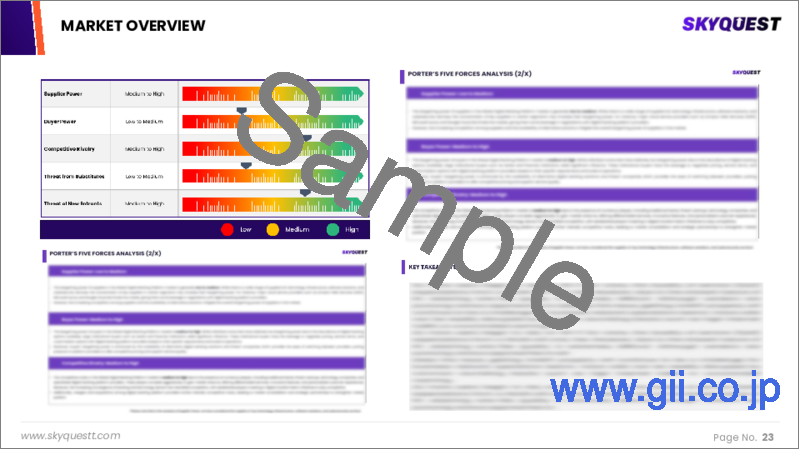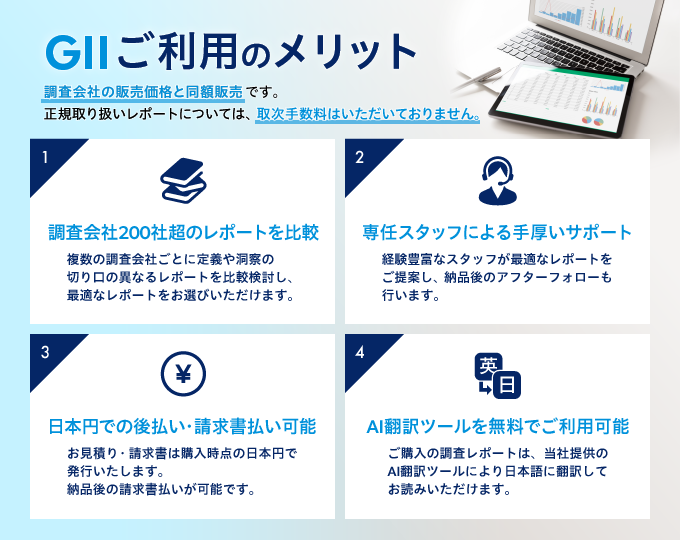|
|
市場調査レポート
商品コード
1619141
光ネットワークハードウェア市場規模、シェア、成長分析、コンポーネント別、技術別、用途別、データレート別、業界別、地域別 - 産業別予測、2024~2031年Optical Network Hardware Market Size, Share, Growth Analysis, By Component (Optical Fibers, Single-Mode Fibers), By Technology (Sonet/Sdh, Wdm), By Application, By Data Rate, By Vertical, By Region - Industry Forecast 2024-2031 |
||||||
|
|||||||
| 光ネットワークハードウェア市場規模、シェア、成長分析、コンポーネント別、技術別、用途別、データレート別、業界別、地域別 - 産業別予測、2024~2031年 |
|
出版日: 2024年12月18日
発行: SkyQuest
ページ情報: 英文 188 Pages
納期: 3~5営業日
|
全表示
- 概要
- 目次
光ネットワークハードウェアの世界市場規模は、2022年に54億米ドルと評価され、2023年の56億5,000万米ドルから2031年には80億9,000万米ドルに成長し、予測期間(2024-2031年)のCAGRは4.6%で成長する見通しです。
世界の光ネットワークハードウェア市場は、多様な分野における高速インターネットと信頼性の高いデータトランスミッションへのニーズの高まりによって、力強い成長を遂げています。データを多用するアプリケーションの急増、5Gやクラウドコンピューティングなどの技術の台頭は、高度な光ネットワークインフラの必要性を浮き彫りにしています。主な成長促進要因には、優れた帯域幅、低遅延、拡張性を提供する光ファイバ通信システムの普及があります。しかし、初期導入コストの高さ、既存システムのアップグレードの複雑さ、規制上の制約などの課題が市場の進展を妨げています。こうした障害にもかかわらず、特に光ハードウェアを最適化するための研究開発において、大きな投資機会が生まれつつあります。エッジコンピューティング、IoTコネクティビティ、5Gネットワークなどの分野での需要拡大は、市場開拓のさらなる道筋を示し、今後のイノベーションを約束します。
目次
イントロダクション
- 調査の目的
- 調査範囲
- 定義
調査手法
- 情報調達
- 二次データと一次データの方法
- 市場規模予測
- 市場の前提条件と制限
エグゼクティブサマリー
- 世界市場の見通し
- 供給と需要の動向分析
- セグメント別機会分析
市場力学と見通し
- 市場概要
- 市場規模
- 市場力学
- 促進要因と機会
- 抑制要因と課題
- ポーターの分析
主な市場の考察
- 重要成功要因
- 競合の程度
- 主な投資機会
- 市場エコシステム
- 市場の魅力指数(2023年)
- PESTEL分析
- マクロ経済指標
- バリューチェーン分析
- 価格分析
- 技術の進歩
- 規制情勢
- ケーススタディ
- 顧客と購買基準の分析
- 貿易分析
- 原材料の分析
光ネットワークハードウェア市場規模:コンポーネント別
- 市場概要
- 光ファイバー
- シングルモードファイバー
- マルチモードファイバー
- 光トランシーバー
- 光増幅器
- エルビウム添加光ファイバー増幅器
- ファイバーラマン増幅器
- 半導体光増幅器
- 光スイッチ
- 光スプリッター
- 光サーキュレータ
- その他
光ネットワークハードウェア市場規模:技術別
- 市場概要
- SONET/SDH
- WDM
- CWDM
- DWDM
- ファイバーチャネル
光ネットワークハードウェア市場規模:用途別
- 市場概要
- 通信
- データセンター
- エンタープライズ
光ネットワークハードウェア市場規模:データレート別
- 市場概要
- 最大40Gbps
- 40Gbps~100Gbps
- 100Gbps以上
光ネットワークハードウェア市場規模:業界別
- 市場概要
- BFSI
- 政府
- ヘルスケア
- クラウド
- エネルギー・公益事業
光ネットワークハードウェア市場規模:地域別
- 北米
- 米国
- カナダ
- 欧州
- ドイツ
- スペイン
- フランス
- 英国
- イタリア
- その他欧州地域
- アジア太平洋地域
- 中国
- インド
- 日本
- 韓国
- その他アジア太平洋地域
- ラテンアメリカ
- ブラジル
- その他ラテンアメリカ地域
- 中東・アフリカ
- GCC諸国
- 南アフリカ
- その他中東・アフリカ
競合情報
- 上位5社の比較
- 主要企業の市場ポジショニング(2023年)
- 主な市場企業が採用した戦略
- 市場の最近の動向
- 企業の市場シェア分析(2023年)
- 主要企業の企業プロファイル
- 会社概要
- 製品ポートフォリオ分析
- セグメント別シェア分析
- 収益の前年比比較(2021-2023)
主要企業プロファイル
- Huawei Technologies
- Cisco Systems
- Ericsson
- Juniper Networks
- Nokia
- ZTE Corporation
- ADVA Optical Networking
- Ciena Corporation
- Infinera
- II-VI Incorporated
- Broadcom Inc.
- Marvell Technology
- Calix, Inc.
- Mitsubishi Electric Corporation
- Corning Incorporated
- Fujitsu Limited
- Arista Networks
- Epson
- Hitachi Communication Technologies
結論と推奨事項
Global Optical Network Hardware Market size was valued at USD 5.4 billion in 2022 and is poised to grow from USD 5.65 billion in 2023 to USD 8.09 billion by 2031, growing at a CAGR of 4.6% during the forecast period (2024-2031).
The global optical network hardware market is experiencing robust growth, driven by the rising need for high-speed internet and reliable data transmission across diverse sectors. The surge in data-heavy applications and the rise of technologies such as 5G and cloud computing highlight the necessity for advanced optical network infrastructure. Key growth drivers include the widespread adoption of fibre optic communication systems, which offer superior bandwidth, low latency, and scalability. However, challenges such as high initial deployment costs, the complexity of upgrading existing systems, and regulatory constraints hinder market progress. Despite these obstacles, significant investment opportunities are emerging, particularly in R&D to optimize optical hardware. The expanding demand in areas like edge computing, IoT connectivity, and 5G networks presents further avenues for market development, promising innovation ahead.
Top-down and bottom-up approaches were used to estimate and validate the size of the Global Optical Network Hardware market and to estimate the size of various other dependent submarkets. The research methodology used to estimate the market size includes the following details: The key players in the market were identified through secondary research, and their market shares in the respective regions were determined through primary and secondary research. This entire procedure includes the study of the annual and financial reports of the top market players and extensive interviews for key insights from industry leaders such as CEOs, VPs, directors, and marketing executives. All percentage shares split, and breakdowns were determined using secondary sources and verified through Primary sources. All possible parameters that affect the markets covered in this research study have been accounted for, viewed in extensive detail, verified through primary research, and analyzed to get the final quantitative and qualitative data.
Global Optical Network Hardware Market Segmental Analysis
Global Optical Network Hardware Market is segmented by component, technology, application, data rate, vertical and region. Based on component, the market is segmented into optical fibers, optical transceivers, optical amplifiers, optical switches, optical splitters, optical circulators and others. Based on technology, the market is segmented into SONET/SDH, WDM, CWDM, DWDM and fiber channel. Based on application, the market is segmented into telecom, data center and enterprise. Based on data rate, the market is segmented into up to 40 GBPS, greater than 40 GBPS to 100 GBPS and greater than 100 GBPS. Based on vertical, the market is segmented into BFSI, government, healthcare, cloud and energy & utilities. Based on region, the market is segmented into North America, Europe, Asia Pacific, Latin America and Middle East & Africa.
Driver of the Global Optical Network Hardware Market
A significant factor propelling the global optical network hardware market is the surging demand for high-speed internet connectivity alongside bandwidth-heavy applications. As activities reliant on substantial data volumes, such as video streaming, cloud computing, online gaming, and the proliferation of IoT devices, continue to rise, there is an increasing necessity for a robust optical network infrastructure. This infrastructure is essential for the efficient and reliable transmission of large data volumes. Optical network hardware, comprising elements like fiber optic cables, transceivers, switches, and routers, is crucial in fulfilling this demand by facilitating rapid data transmission over extensive distances with minimal latency, thus stimulating market growth.
Restraints in the Global Optical Network Hardware Market
One of the significant constraints facing the Global Optical Network Hardware market is the high initial investment costs coupled with challenges in deploying the necessary infrastructure. Establishing optical network infrastructure entails substantial capital outlay for components such as fiber optic cables, network equipment, installation, and ongoing maintenance. This financial barrier is particularly pronounced in urban environments, where securing rights-of-way, obtaining necessary permits, and addressing regulatory hurdles can complicate the development process. These factors contribute to inflated overall project costs and extended timelines for deployment, ultimately hindering growth opportunities for suppliers and manufacturers within the optical network hardware sector.
Market Trends of the Global Optical Network Hardware Market
The Global Optical Network Hardware market is witnessing a significant trend towards faster speeds and increased bandwidth capacity, fueled by the surge in data consumption driven by advanced technologies such as 5G, IoT, and cloud computing. As enterprises and service providers seek solutions to accommodate ultra-fast data transmission rates, the demand for high-capacity optical network gear is rapidly expanding. This shift is prompting manufacturers to innovate and enhance their product offerings, focusing on solutions that ensure scalability, reliability, and cost-effectiveness. As these technologies continue to evolve, the optical network hardware segment is positioned for substantial growth in the coming years.
Table of Contents
Introduction
- Objectives of the Study
- Scope of the Report
- Definitions
Research Methodology
- Information Procurement
- Secondary & Primary Data Methods
- Market Size Estimation
- Market Assumptions & Limitations
Executive Summary
- Global Market Outlook
- Supply & Demand Trend Analysis
- Segmental Opportunity Analysis
Market Dynamics & Outlook
- Market Overview
- Market Size
- Market Dynamics
- Drivers & Opportunities
- Restraints & Challenges
- Porters Analysis
- Competitive rivalry
- Threat of substitute
- Bargaining power of buyers
- Threat of new entrants
- Bargaining power of suppliers
Key Market Insights
- Key Success Factors
- Degree of Competition
- Top Investment Pockets
- Market Ecosystem
- Market Attractiveness Index, 2023
- PESTEL Analysis
- Macro-Economic Indicators
- Value Chain Analysis
- Pricing Analysis
- Technological Advancement
- Regulatory Landscape
- Case Studies
- Customer & Buying Criteria Analysis
- Trade Analysis
- Raw Material Analysis
Global Optical Network Hardware Market Size by Component & CAGR (2024-2031)
- Market Overview
- Optical Fibers
- Single-Mode Fibers
- Multi-Mode Fibers
- Optical Transceivers
- Optical Amplifiers
- Erbium-Doped Fiber Amplifiers
- Fiber Raman Amplifiers
- Semiconductor Optical Amplifiers
- Optical Switches
- Optical Splitters
- Optical Circulators
- Others
Global Optical Network Hardware Market Size by Technology & CAGR (2024-2031)
- Market Overview
- SONET/SDH
- WDM
- CWDM
- DWDM
- Fiber Channel
Global Optical Network Hardware Market Size by Application & CAGR (2024-2031)
- Market Overview
- Telecom
- Data Center
- Enterprise
Global Optical Network Hardware Market Size by Data Rate & CAGR (2024-2031)
- Market Overview
- Up To 40 Gbps
- Greater Than 40 Gbps To 100 Gbps
- Greater Than 100 Gbps
Global Optical Network Hardware Market Size by Vertical & CAGR (2024-2031)
- Market Overview
- Bfsi
- Government
- Healthcare
- Cloud
- Energy & Utilities
Global Optical Network Hardware Market Size & CAGR (2024-2031)
- North America (Component, Technology, Application, Data Rate, Vertical)
- USA
- Canada
- Europe (Component, Technology, Application, Data Rate, Vertical)
- Germany
- Spain
- France
- UK
- Italy
- Rest of Europe
- Asia Pacific (Component, Technology, Application, Data Rate, Vertical)
- China
- India
- Japan
- South Korea
- Rest of Asia-Pacific
- Latin America (Component, Technology, Application, Data Rate, Vertical)
- Brazil
- Rest of Latin America
- Middle East & Africa (Component, Technology, Application, Data Rate, Vertical)
- GCC Countries
- South Africa
- Rest of Middle East & Africa
Competitive Intelligence
- Top 5 Player Comparison
- Market Positioning of Key Players, 2023
- Strategies Adopted by Key Market Players
- Recent Developments in the Market
- Company Market Share Analysis, 2023
- Company Profiles of All Key Players
- Company Details
- Product Portfolio Analysis
- Company's Segmental Share Analysis
- Revenue Y-O-Y Comparison (2021-2023)
Key Company Profiles
- Huawei Technologies
- Company Overview
- Business Segment Overview
- Financial Updates
- Key Developments
- Cisco Systems
- Company Overview
- Business Segment Overview
- Financial Updates
- Key Developments
- Ericsson
- Company Overview
- Business Segment Overview
- Financial Updates
- Key Developments
- Juniper Networks
- Company Overview
- Business Segment Overview
- Financial Updates
- Key Developments
- Nokia
- Company Overview
- Business Segment Overview
- Financial Updates
- Key Developments
- ZTE Corporation
- Company Overview
- Business Segment Overview
- Financial Updates
- Key Developments
- ADVA Optical Networking
- Company Overview
- Business Segment Overview
- Financial Updates
- Key Developments
- Ciena Corporation
- Company Overview
- Business Segment Overview
- Financial Updates
- Key Developments
- Infinera
- Company Overview
- Business Segment Overview
- Financial Updates
- Key Developments
- II-VI Incorporated
- Company Overview
- Business Segment Overview
- Financial Updates
- Key Developments
- Broadcom Inc.
- Company Overview
- Business Segment Overview
- Financial Updates
- Key Developments
- Marvell Technology
- Company Overview
- Business Segment Overview
- Financial Updates
- Key Developments
- Calix, Inc.
- Company Overview
- Business Segment Overview
- Financial Updates
- Key Developments
- Mitsubishi Electric Corporation
- Company Overview
- Business Segment Overview
- Financial Updates
- Key Developments
- Corning Incorporated
- Company Overview
- Business Segment Overview
- Financial Updates
- Key Developments
- Fujitsu Limited
- Company Overview
- Business Segment Overview
- Financial Updates
- Key Developments
- Arista Networks
- Company Overview
- Business Segment Overview
- Financial Updates
- Key Developments
- Epson
- Company Overview
- Business Segment Overview
- Financial Updates
- Key Developments
- Hitachi Communication Technologies
- Company Overview
- Business Segment Overview
- Financial Updates
- Key Developments






